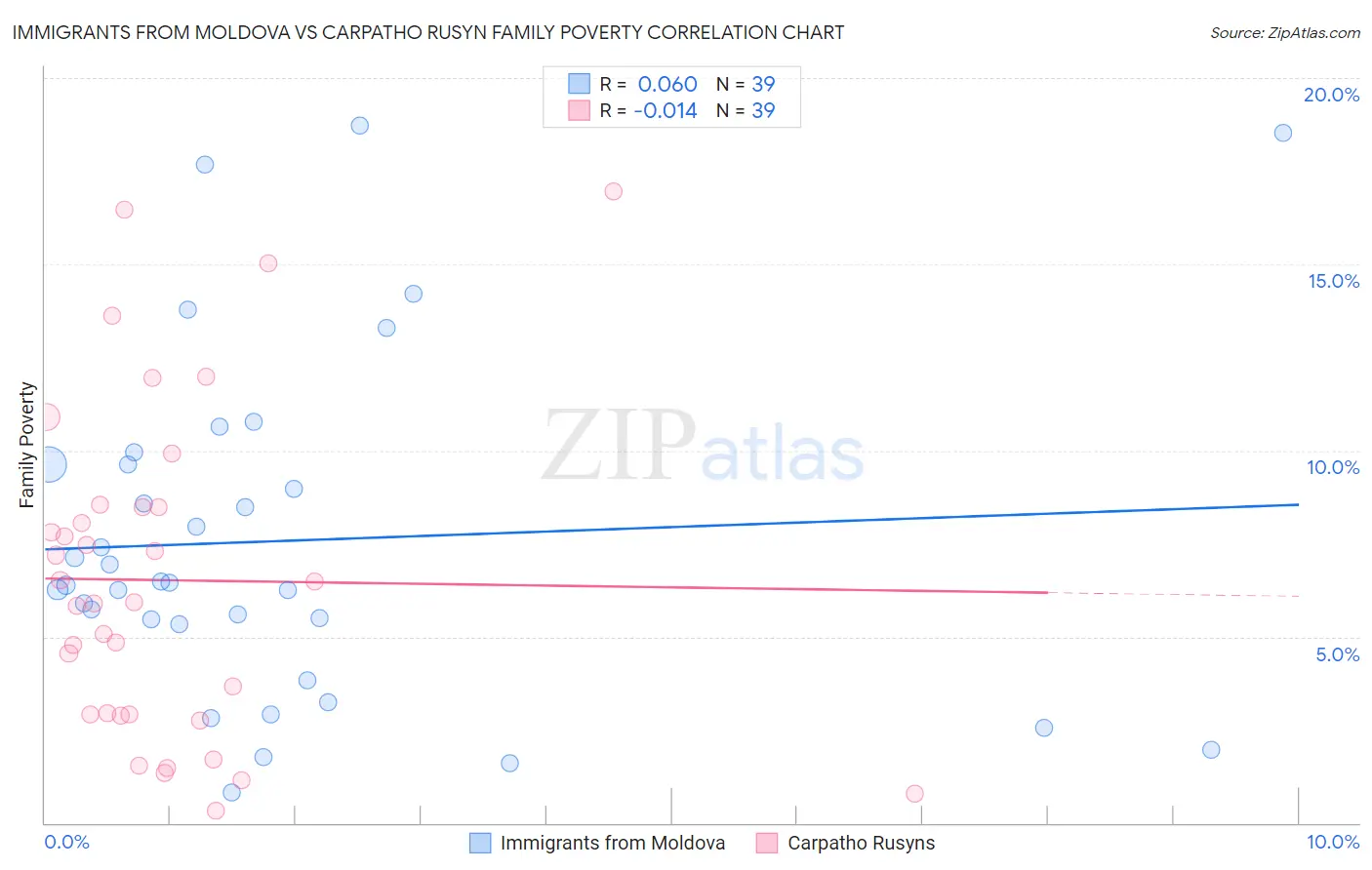Immigrants from Moldova vs Carpatho Rusyn Family Poverty
COMPARE
Immigrants from Moldova
Carpatho Rusyn
Family Poverty
Family Poverty Comparison
Immigrants from Moldova
Carpatho Rusyns
7.7%
FAMILY POVERTY
98.8/ 100
METRIC RATING
51st/ 347
METRIC RANK
7.5%
FAMILY POVERTY
99.3/ 100
METRIC RATING
39th/ 347
METRIC RANK
Immigrants from Moldova vs Carpatho Rusyn Family Poverty Correlation Chart
The statistical analysis conducted on geographies consisting of 124,316,177 people shows a slight positive correlation between the proportion of Immigrants from Moldova and poverty level among families in the United States with a correlation coefficient (R) of 0.060 and weighted average of 7.7%. Similarly, the statistical analysis conducted on geographies consisting of 58,816,515 people shows no correlation between the proportion of Carpatho Rusyns and poverty level among families in the United States with a correlation coefficient (R) of -0.014 and weighted average of 7.5%, a difference of 2.1%.

Family Poverty Correlation Summary
| Measurement | Immigrants from Moldova | Carpatho Rusyn |
| Minimum | 0.83% | 0.31% |
| Maximum | 18.7% | 16.9% |
| Range | 17.9% | 16.6% |
| Mean | 7.6% | 6.5% |
| Median | 6.4% | 5.9% |
| Interquartile 25% (IQ1) | 5.3% | 2.9% |
| Interquartile 75% (IQ3) | 9.6% | 8.5% |
| Interquartile Range (IQR) | 4.3% | 5.6% |
| Standard Deviation (Sample) | 4.5% | 4.4% |
| Standard Deviation (Population) | 4.5% | 4.3% |
Demographics Similar to Immigrants from Moldova and Carpatho Rusyns by Family Poverty
In terms of family poverty, the demographic groups most similar to Immigrants from Moldova are Immigrants from North Macedonia (7.7%, a difference of 0.15%), Indian (Asian) (7.7%, a difference of 0.16%), Immigrants from Bolivia (7.7%, a difference of 0.18%), Swiss (7.7%, a difference of 0.22%), and Immigrants from Sweden (7.7%, a difference of 0.23%). Similarly, the demographic groups most similar to Carpatho Rusyns are Slovene (7.5%, a difference of 0.040%), Bolivian (7.5%, a difference of 0.060%), Estonian (7.5%, a difference of 0.31%), Immigrants from Australia (7.6%, a difference of 0.34%), and Turkish (7.5%, a difference of 0.47%).
| Demographics | Rating | Rank | Family Poverty |
| Greeks | 99.4 /100 | #35 | Exceptional 7.5% |
| Turks | 99.4 /100 | #36 | Exceptional 7.5% |
| Estonians | 99.4 /100 | #37 | Exceptional 7.5% |
| Bolivians | 99.3 /100 | #38 | Exceptional 7.5% |
| Carpatho Rusyns | 99.3 /100 | #39 | Exceptional 7.5% |
| Slovenes | 99.3 /100 | #40 | Exceptional 7.5% |
| Immigrants | Australia | 99.2 /100 | #41 | Exceptional 7.6% |
| Scandinavians | 99.1 /100 | #42 | Exceptional 7.6% |
| Immigrants | Austria | 99.1 /100 | #43 | Exceptional 7.6% |
| Germans | 99.0 /100 | #44 | Exceptional 7.7% |
| Okinawans | 98.9 /100 | #45 | Exceptional 7.7% |
| Tongans | 98.9 /100 | #46 | Exceptional 7.7% |
| Immigrants | Czechoslovakia | 98.9 /100 | #47 | Exceptional 7.7% |
| Immigrants | Sri Lanka | 98.9 /100 | #48 | Exceptional 7.7% |
| Immigrants | Bolivia | 98.9 /100 | #49 | Exceptional 7.7% |
| Immigrants | North Macedonia | 98.9 /100 | #50 | Exceptional 7.7% |
| Immigrants | Moldova | 98.8 /100 | #51 | Exceptional 7.7% |
| Indians (Asian) | 98.8 /100 | #52 | Exceptional 7.7% |
| Swiss | 98.8 /100 | #53 | Exceptional 7.7% |
| Immigrants | Sweden | 98.8 /100 | #54 | Exceptional 7.7% |
| Immigrants | Eastern Asia | 98.7 /100 | #55 | Exceptional 7.7% |